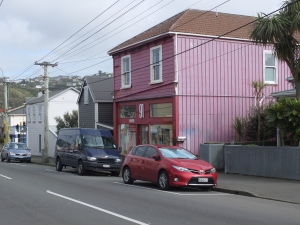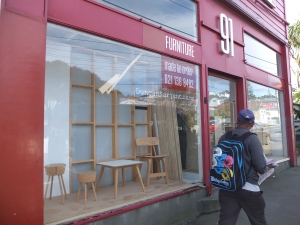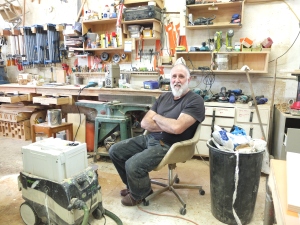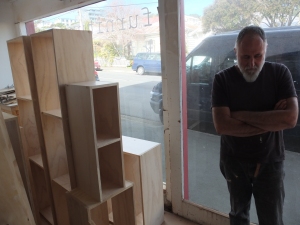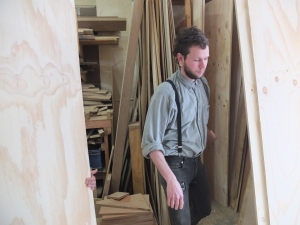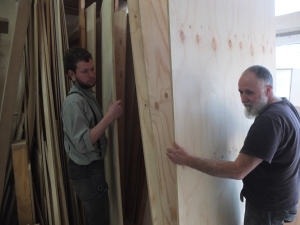In a big old red building on Constable Street, Duncan Sargent makes furniture and kitchens.
Built in 1915 during the First World War, the building was a dry-goods store before the introduction of refrigerators and bags of frozen peas.
At one stage, it was owned by two brothers from Shetland Island, each eight-foot tall.
When Duncan bought the place in 1989, he found the old shop book in the wall cavity, with lists of tea, sugar, flour and tobacco – all in tuppences and sixpences.
I had walked past his shop window many times before, always looking through the glass to get a view of the workshop and checking out the furniture.
I wondered if it smelt like the same freshly shaven timber, oils, varnishes, and secret cigarettes that my Poppas shed did – maybe seeking nostalgia, I went in to find out.
Duncan wore dirty old jeans with a dangly leather belt and a black stretched out t-shirt. He had a grey beard and looked a bit like he could be in a metal band.
From out of the t-shirt came two arms, strong and worn from years of woodwork, and fingers bandaged and crooked in places.
He wore what looked like a pair of very good quality leather shoes.
After growing up in the Hutt, Duncan went to Ilam School of Fine Arts in Christchurch and went on to work on documentaries for the National Film Unit.
I asked Duncan how he moved from documentaries, to kitchens and furniture:
“I got sick of talking…. and I had this hankering to be working…doing something with my hands”.
Back down in Wellington, Duncan got a job as a postie and rented an art studio on Willis street where he began to paint. He also began to make clocks and other small items after seeing a friend do the same.
With what seemed like such a drastic change – from documentaries to constructing objects – I wanted to know how Duncan learnt this new set of skills.
“ I just picked them up from friendly people who showed me how to do it…and I copied them…” Duncan told me
“ … and the clocks sold quite well so I thought, ‘I’ll make more of those!’, and I quit my job as a postie”.
Owen is Duncan’s Employee. Owen came to New Zealand about five months ago with just a bike and a few clothes stuffed down in between the bike frame.
He told me stories of Boston winters with snow piled double above head on either side of the footpath, and even snow tunnels dug by cyclists.
He is trained as an industrial engineer, used to be a wooden boat builder, and had plans to build a canoe out of paper mache like the Victorians used to do, apparently.
In front of the workshop fireplace, the three of us discussed the ethics around native timber, and plywood without formaldehyde and arsenic, and a bloke from up Waikanae who has a saw mill and drags huge native pine trees out of gullies where they had been dropped years before.
“…and he air dries the timber. So he cuts it and leaves it, whereas usually it’s dried at an extremely high temperature…So this way takes longer, but the wood doesn’t fracture or splinter…”
Duncan and Owen have just finished a Matai bench-top that must have been a couple of hundred years old.
“it had a beautiful grain and colour gradient….It started light down one end and then went this quite dark colour. It did smell a bit of urine though”
They tell me this is the best way to identify native timbers, which often look quite similar- they each have their own smell.
Duncan just turned 60 and he’s still thinking what to do next.
“Last year was crap, but this years turning out pretty good”.
He has no ambition to be Ikea (who Owen, the paper mache boat builder tells me uses 2% of the worlds paper!). In fact, he might even downsize and begin to make smaller items, like back in the beginning.
But for now, he’s happy with the way things are going along.
I left the workshop as Owen and Duncan began moving big sheets of good quality plywood that had been dropped-off that morning.

